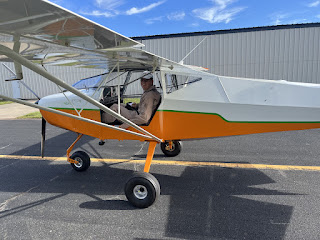We finally received our airworthiness certificate on Aug 20, but had some work to do before first flight. During our trip to Brasstown for transition training, our flight instructor (Vic) at Plane Fun Aircraft gave us many tips, and strongly recommended that we add vortex generators (VGs) before first flight. These should lower stall speed a bit and they reportedly do not affect top speed. We originally planned on adding them post flight to gauge their effectiveness, but changed our minds after talking to him.
The VGs that came with our kit had sharp corners and no adhesive (they recommended a form of super glue). We elected to order some new ones (Stolspeed VGs) as these had a more rounded shape and came with 3M adhesive that is removable. We installed them per instructions. The VGs at the wing tips are installed with a closer spacing to ensure the wing tips stall after the root wing stalls. We also installed VGs on the bottom of the horizontal stabilizers.
 |
| VGs on the wing |
 |
| VGs on horizontal stabilizer |
Also, even though our wings were rigged at the factory, we were advised to double check this According to Vic, If the wing is leveled at the root, and measures something like -1 or -1.5 degree angle at the center (angle of incidence), then it should be about -2 to -3 degrees at the wing tip. Having a little twist like helps ensure that the wing tips will stall after the main wing stalls. More important is to ensure that both wings are identical. When we measured our wings, we found that the right wing was close to level across the whole span (no twist). The left wing was a little better but had just -0.8 degrees at the tip. We adjusted the right wing as far as allowed by loosening the jury strut and then rotating the main strut's clevis fork rod end, and were able to get it to -1.2 degrees at the tip (with about 0.6 degrees center). The left wing was then adjusted to match this.
We also ran another taxi test. This time it was a higher speed taxi test down the runway. Power was applied gradually while holding back the stick until the nose lifted off the ground, then reduced to hold the position. The test went well, although we noted that the airspeed on our Garmin G3x never dropped under 23 MPH. We contacted Garmin and found that this means we need to have our GSU25c (ADAHRS) replaced. Luckily, this will be covered under warranty.
We are also finding that our coolant temps still run a little high during taxi on hot days so we may need to adjust the cowling opening and/or radiator position sometime in the future to improve this.









































